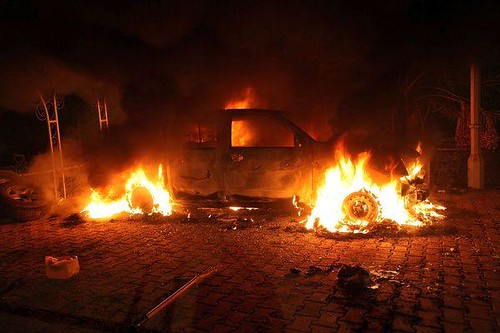
Scene outside the United States Consulate in Benghazi, Libya after the building was bombed. The U.S. ambassador and three other personnel were killed in the attacks., a photo by Pan-African News Wire File Photos on Flickr.
Panetta: DOD moved quickly on Libya attack
Sunday, November 11, 2012, 2:02 PM
Defense Secretary Leon Panetta says the U.S. military "did everything they were in position to do" about the attack on the U.S. consulate in Libya.
In a letter and timeline sent to Sen. John McCain (R-Ariz.), the ranking member of the Senate Armed Services Committee, Panetta said the Sept. 11 attack on the consulate and nearby annex in Benghazi were over before U.S. forces could arrive.
In the meantime, he said, the Defense Department diverted a nearby unarmed, unmanned drone to the consulate and dispatched special operations forces from Europe and the United States.
"The department's senior leaders and I spared no effort to save the lives of our American colleagues, as we worked to bolster security in response to a series of other threats in the region occurring at the same time," Panetta said.
Still, it's unclear whether Panetta's explanation and timeline will satisfy members of Congress who continue to press the administration for more details and transparency about the attack.
The Senate Foreign Relations Committee is holding a closed hearing on the attack and its aftermath on Wednesday, and the Senate Select Committee on Intelligence is convening another one on Thursday.
A spokeswoman for Sen. Saxby Chambliss (R-Ga.), the ranking member of the Senate Intelligence Committee, told POLITICO Friday his panel will continue its investigation of the attack.
And the House Oversight and Government Reform Committee will also continue "to investigate the Benghazi tragedy and the events that led up to it," said Becca Watkins, a spokeswoman for committee chairman Rep. Darrell Issa (R-Calif.).
In his letter, Panetta said he wanted to specifically address the question of why no armed U.S. aircraft were used to stop the attack.
"Armed UAVs, AC-130 gunships, or fixed-wing fighters with the associated tanking, armaments, targeting and support capabilities were not in the vicinity of Libya nor postured to an effective operational option during the timeframe of this attack," he said.
The Pentagon timeline includes no information on the activities of the State Department or the CIA.
Leading up to Sept. 11, U.S. military forces were positioned throughout Europe and the Middle East to respond to a variety of contingencies, Panetta said. As Joint Chiefs of Staff Chairman Gen. Martin Dempsey has noted, "It was 9/11 everywhere in the world," on the 11th anniversary of the Sept. 11, 2001, terrorist attacks on New York and Washington.
Several hundred reports had been received about threats to U.S. facilities around the world, Panetta said.
In the Middle East and North Africa, U.S. facilities in more than 16 countries were operating under a heightened force protection level, Panetta said.
But, he made clear, "We had no advanced notice that threats to U.S. personnel or facilities in Benghazi were imminent."
According to the timeline:
On Sept. 11, at 3:42 p.m., EDT, the U.S. consulate in Benghazi came under attack.
At 3:59 p.m., an unarmed, unmanned surveillance aircraft was redirected. At 5:10 p.m., the drone arrived overhead the consulate. Later, a second drone was directed to relieve the first one.
Shortly after 4:30 p.m., Panetta and Dempsey started receiving reports about the attack in Benghazi. They were already headed to a previously scheduled meeting with the White House when the reports started coming in.
"Upon hearing these initial reports, the president ordered us to use all available DoD assets to respond to the attack and save the lives of U.S. personnel in Libya and to protect U.S. personnel and interests throughout the region," Panetta said.
Panetta and Dempsey also ordered the Joint Staffs to immediately assess all available response forces.
Meanwhile, Benghazi wasn't the only place the Pentagon was watching, having anticipated possible responses to events in Tunis, Tripoli, Cairo, Sana'a and elsewhere.
Panetta said he ordered military forces into position for "a range of missions, including a hostage rescue of U.S. personnel if that were to become necessary, as well as deterring and countering attacks throughout the region."
In addition to the drone and a six-man team sent from the U.S. Embassy in Tripoli, including two U.S. military personnel, Panetta ordered the deployment of three additional response forces: two Marine FAST (Fleet Anti-terrorism Security Team) platoons from Rota, Spain; a special operations team from U.S. European Command that was conducting a training mission in Central Europe; and a special operations task force from the East Coast of the United States.
The forces were ordered to move to an intermediate staging base in southern Europe. But before they arrived there, the attack in Benghazi was over, and U.S. Ambassador Christopher Stevens and three other Americans had been killed.
The special operations units from Europe and the United States arrived at the staging base hours after U.S. personnel had flown out of Libya on a C-17 aircraft stationed in Germany.
On Sept. 12, a Marine FAST platoon arrived in Tripoli to enhance the embassy's security team, while the Pentagon also deployed a small team of special operations forces to the U.S. Embassy in Tunis.
This article first appeared on POLITICO Pro at 5:35 p.m. on November 9, 2012.
No comments:
Post a Comment